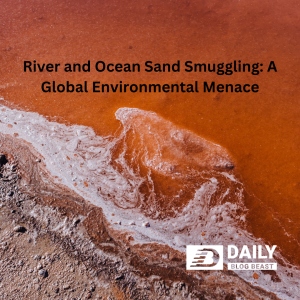Introduction
Sand is often overlooked as a natural resource, yet it plays a pivotal role in various industries, including construction and manufacturing. Sand, sourced from rivers and oceans, is essential for creating concrete, glass, and silicon chips, among other products. However, the extraction and smuggling of river and ocean sand have become a grave concern, with detrimental environmental and socio-economic consequences. This essay delves into the issue of sand smuggling, shedding light on its harmful side effects on both local ecosystems and global economies.
The Sand Smuggling Epidemic
Sand smuggling, also known as illegal sand mining, involves the unauthorized extraction and transportation of sand from rivers, oceans, and coastal areas. This clandestine activity has seen a dramatic rise in recent years due to increasing global demand for sand, driven primarily by the construction industry’s insatiable appetite for concrete. The unregulated and often destructive nature of sand mining operations poses serious threats to the environment.
Environmental Impacts
A. Erosion and Habitat Destruction River sand is integral in maintaining riverbanks and coastal areas. Illicit sand mining disrupts natural sediment balance, leading to accelerated erosion, which, in turn, affects ecosystems, fisheries, and local communities. The removal of sand destabilizes riverbeds, exacerbating flooding and causing long-term damage.
B. Biodiversity Loss Ocean and river ecosystems are delicate and interconnected. Sand mining disrupts aquatic habitats, leading to biodiversity loss. Species that rely on these environments for breeding, feeding, and shelter are threatened or pushed to extinction. In particular, sea turtles, fish, and crustaceans suffer the consequences of this activity.
C. Water Quality Sand mining can contaminate water sources through sedimentation, impacting the quality of drinking water and harming aquatic life. The silt and sediment stirred up during mining operations can smother aquatic vegetation and disrupt the food chain, ultimately affecting human communities reliant on these resources.
Social and Economic Impacts
A. Displacement of Communities Many sand mining operations are located in regions inhabited by marginalized communities. The disruption caused by these operations often forces these communities to relocate, leading to social instability and loss of cultural heritage.
B. Violation of Rights Sand smuggling frequently occurs in areas with lax regulatory oversight, where illegal operators exploit weak legal frameworks. This results in the violation of land rights, as landowners and indigenous populations are frequently displaced without adequate compensation.
C. Economic Losses Sand smuggling not only damages local ecosystems but also affects economies. Coastal regions and riverbanks are often prime tourist destinations. The environmental degradation caused by illegal sand mining negatively impacts tourism revenue, thereby hurting local economies.
Global Impact
The consequences of sand smuggling extend far beyond the immediate affected areas. As global demand for sand continues to rise, the smuggling of this precious resource contributes to a booming underground market, driven by the prospect of high profits. This criminal network can have wide-reaching consequences:
A. Market Distortion The black market for sand distorts global supply chains and exacerbates the imbalance in sand availability. Legal mining operations and construction industries that rely on legitimate sand sources face unfair competition, potentially leading to economic instability.
B. Environmental Footprint Sand smuggling results in increased carbon emissions, as illegal transport activities often involve heavy machinery and unregulated transportation methods. This contributes to climate change, further exacerbating the environmental crisis.
C. Security Concerns The illicit sand trade often intersects with other criminal activities, such as money laundering and organized crime. The involvement of criminal networks in sand smuggling can pose serious security threats, both locally and globally.
Conclusion
The smuggling of river and ocean sand is a global environmental menace with far-reaching consequences. Its harmful side effects include erosion, habitat destruction, biodiversity loss, water pollution, displacement of communities, violation of rights, and economic losses. Moreover, it distorts global markets, contributes to environmental degradation, and raises security concerns. Addressing this issue requires not only stricter regulations but also global cooperation to combat the illicit sand trade and promote sustainable sand mining practices. Without concerted efforts, the harmful impacts of sand smuggling will continue to undermine the health of our planet and the well-being of communities around the world.


